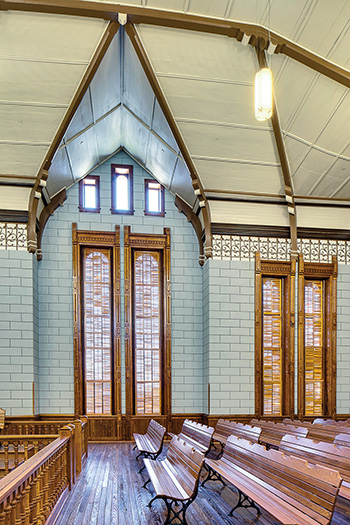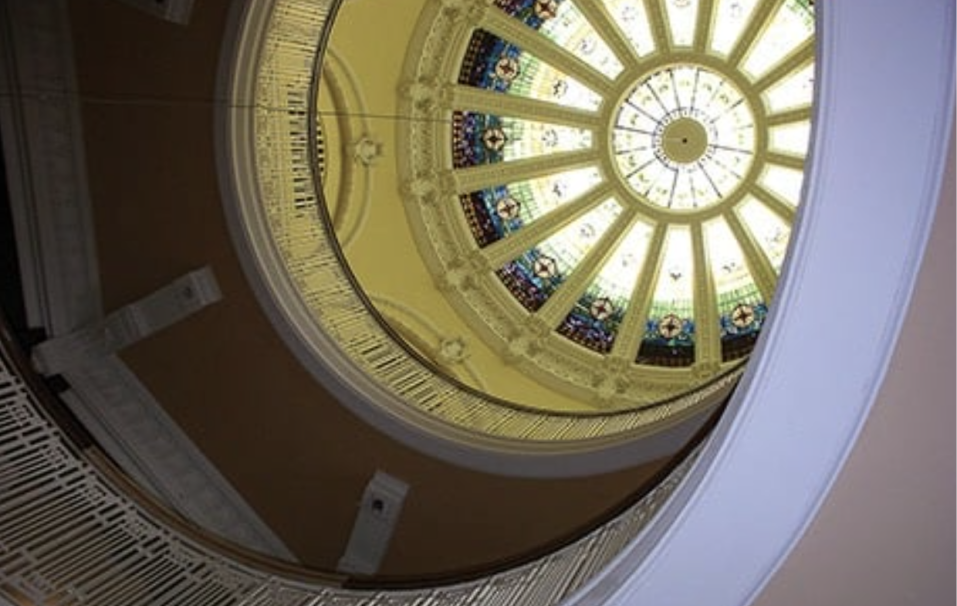By Farah Merchant, THC Preservation Scholar
Protecting history and the environment are not mutually exclusive. Most of Texas’ courthouse restoration projects preserve the historic integrity of prominent county structures while implementing sustainable practices.
Some of the state’s historic courthouses operate inefficiently, using an abundance of energy to heat and cool the interior due to lack of window maintenance, inadequate insulation, and modern electrical practices. However, recent restorations address these issues while maintaining the courthouses’ historic design and function.
According to Texas Historical Commission (THC) architects, restoring courthouses and other historic buildings is inherently green due to the use of previous construction (aka embodied energy) and passive climate-responsive designs, such as solar shading from deep entry porches, daylight use, and durable materials. Most restoration projects, however, make buildings even greener through energy-efficient electrical systems, which maximize control over thermal loss and gain.
Bess Althaus Graham, the THC’s Architecture Division director, has overseen several courthouse restoration projects that implemented ground-source heat pump systems. The Trinity and Hamilton county courthouses use the earth’s constant temperature to preheat or pre-cool water used in the HVAC systems. Buried underground, the system is highly efficient and invisible. The restoration of the La Salle and Hood county courthouses also used similar systems incorporating heat-pump systems to reduce energy use and the buildings’ carbon footprints.
Another energy-efficient courthouse feature is a cool roof, which reflects sunlight and absorbs less heat than a standard roof through reflective paint, sheet covering, or reflective tiles or shingles. Also, courthouses updated with modern systems use new technologies that increase energy efficiency and reduce water waste.
To further lessen the amount of energy needed to power courthouses, restoration plans typically focus on insulating attics. This balances temperature and reduces the need to overwork the air conditioner or heater, since the tops and bottoms of buildings are more susceptible to heat or cooling loss. These areas are also easier to insulate than perimeter walls and openings, without sacrificing these key historic features.
Reduce and Reuse
Along with shifting to more-renewable sources and reducing energy consumption, reusing materials and taking advantage of existing infrastructure is imperative for sustainability.

For example, original windows are rehabilitated to allow future maintenance by replacing deteriorated window parts over time. Rehabilitating these historic windows is more sustainable than replacing the entire window panel with newer models that have a life expectancy of 20–30 years. The Hood County Courthouse restoration included restored window sashes and frames and a shutter-track system, which allows for natural light while preventing the building from heating.
Like most preservationists, Susan Tietz, coordinator of the THC’s Courthouse Preservation Program, is a strong proponent of preservation rather than the replacement of building elements, which reduces waste going to landfills and the need to use new materials.
“It’s inherently sustainable,” Tietz said. “It would waste so much energy to demolish those buildings. There is already so much embodied energy in the courthouses, and the buildings and materials used in them are durable. They’ve already lasted a hundred years and, if they’re well maintained, they’ll last indefinitely.”
For her, sustainability is an important aspect of restoration, but so is respecting the historical integrity of the buildings. She believes the energy invested in constructing a landmark such as a courthouse needs to be preserved to remember the past and honor those who came before us.
“At the time they were built, these counties, in most cases, borrowed substantial amounts of money and often hired famous architects to design their courthouses, even in small rural communities,” Tietz said. “Courthouses were considered important buildings, so most counties hired the most prominent architect they could afford to design their courthouse.”
Courthouse Coexistence
Graham claims there are new environmental issues on the horizon, such as climate change, net-zero construction, and the difficulty of restoring, repairing, and maintaining materials introduced by the Modern style following World War II.
She says adopting the LEED (Leadership in Energy and Environmental Design) environmental rating system combines preservation and sustainability. Many architects don’t use this system due to the misconception that LEED clashes with the Secretary of the Interior’s Standards, a guide for maintaining the integrity of historic buildings. Graham points out that the latest version of LEED focuses on the source and life cycle of materials, which supports historic buildings’ efforts to reuse materials.
“The LEED rating system is effective because each point is associated with a measurable goal and verified by a third party,” Graham said. “Preservation and sustainability can coexist very well, as long as both sides understand each other and their assumptions.”
Tietz adds that more needs to be incorporated into grant-funded courthouse restoration projects; she hopes to use her position to expand the Courthouse Preservation Program’s involvement to ensure the most sustainable outcome.
“The program could do more to encourage project architects to focus on sustainability when choosing materials or methods,” said Tietz. “Most of the architecture firms do tend toward sustainable design anyway, but our program doesn’t require it. We can all do our part to help ensure these historically significant buildings are sustainable and preserved for future generations of Texans to use and enjoy.”

